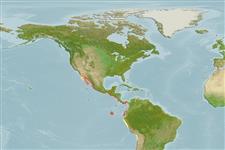>
Eupercaria/misc (Various families in series Eupercaria) >
Labridae (Wrasses) > Bodianinae
Etymology: Bodianus: Bodianus after Bodiano or Pudiano, from the Portuguese pudor, meaning modesty (Jordan & Evermann, 1896).; diplotaenia: Name from the Greek diploos, meaning 'twofold', and feminine noun tainia for ribbon, referring to the two prominent dark stripes on the body of juveniles and initial phase adults (Ref. 75973).
More on author: Gill.
Environment: milieu / climate zone / depth range / distribution range
Sinh thái học
Biển Cùng sống ở rạn san hô; Mức độ sâu 5 - 76 m (Ref. 9311), usually 5 - 18 m (Ref. 9311). Subtropical; 32°N -
Eastern Pacific: Guadalupe Island and throughout the Gulf of California to Chile, including the Cocos, Malpelo, Revillagigedo and the Galapagos islands.
Bộ gần gũi / Khối lượng (Trọng lượng) / Age
Maturity: Lm ? range ? - ? cm
Max length : 76.0 cm TL con đực/không giới tính; (Ref. 5592); common length : 45.0 cm TL con đực/không giới tính; (Ref. 55763); Khối lượng cực đại được công bố: 9.0 kg (Ref. 5592)
Body moderately deep and compressed; head large and pointed; teeth caniniform, enlarged, and somewhat crooked, two anterior pairs in each jaw; dorsal fin with 12 spines; posterior rays of anal and dorsal fins forming filamentous lobes; lower branch of first gill arch with 12 to 13 gill rakers; very large individuals blue, with a narrow, yellow, vertical bar immediately behind the posterior edge of the pectoral fin, juveniles red or reddish brown; females with 2 longitudinal black stripes (Ref. 55763).
Adults inhabit rocky or coral areas (Ref. 9311). Sometimes also found on sandy bottoms and where marine plants abound (Ref. 9311). Solitary or forms aggregations of only a few individuals. Feed on crabs, brittle stars, mollusks, and sea urchins (Ref. 9311). At night, they agglomerate in cracks and crevices of rocks and caves to sleep (Ref. 9311). Marketed fresh (Ref. 9311). Starts life as a female, later becoming a functional male. Males defend temporary reproductive territories called leks. Sex change may be due to local social conditions, but it may also have a genetic component, since the reversal occurs over a limited size range (Ref. 28023). Oviparous, distinct pairing during breeding (Ref. 205).
Life cycle and mating behavior
Chín muồi sinh dục | Sự tái sinh sản | Đẻ trứng | Các trứng | Sự sinh sản | Ấu trùng
Oviparous, distinct pairing during breeding (Ref. 205).
Thomson, D.A., 1987. Reef fishes of the Sea of Cortez. The rocky-shore fishes of the Gulf of California. The University of Arizona Press, Tucson. 302 p. (Ref. 5592)
IUCN Red List Status (Ref. 130435)
Threat to humans
Harmless
Human uses
Bể nuôi cá: Tính thương mại
Thêm thông tin
Các tài liệu tham khảoNuôi trồng thủy sảnTổng quan nuôi trồng thủy sảnCác giốngDi truyềnElectrophoresesDi sảnCác bệnhChế biếnNutrientsMass conversion
Các công cụ
Special reports
Download XML
Các nguồn internet
Estimates based on models
Preferred temperature (Ref.
123201): 20.6 - 28.9, mean 26.2 °C (based on 286 cells).
Phylogenetic diversity index (Ref.
82804): PD
50 = 0.5000 [Uniqueness, from 0.5 = low to 2.0 = high].
Bayesian length-weight: a=0.01202 (0.00551 - 0.02625), b=3.05 (2.87 - 3.23), in cm total length, based on LWR estimates for this Genus-body shape (Ref.
93245).
Mức dinh dưỡng (Ref.
69278): 3.4 ±0.46 se; based on food items.
Thích nghi nhanh (Ref.
120179): Rất thấp, thời gian nhân đôi của chủng quần tối thiểu là hơn 14 năm (Preliminary K or Fecundity.).
Fishing Vulnerability (Ref.
59153): Moderate to high vulnerability (50 of 100).
Nutrients (Ref.
124155): Calcium = 18.5 [9.0, 35.3] mg/100g; Iron = 0.479 [0.265, 0.904] mg/100g; Protein = 19.3 [16.4, 21.5] %; Omega3 = 0.189 [0.109, 0.326] g/100g; Selenium = 19.3 [9.6, 36.8] μg/100g; VitaminA = 44.1 [13.7, 174.4] μg/100g; Zinc = 0.775 [0.531, 1.280] mg/100g (wet weight);
